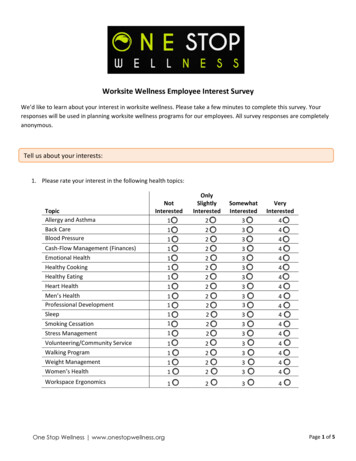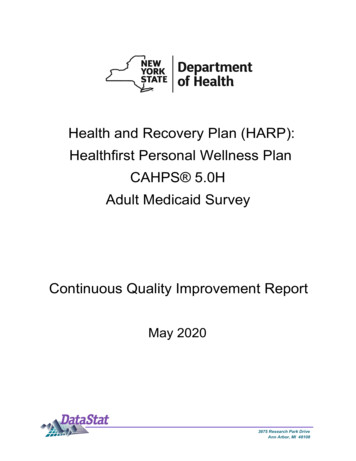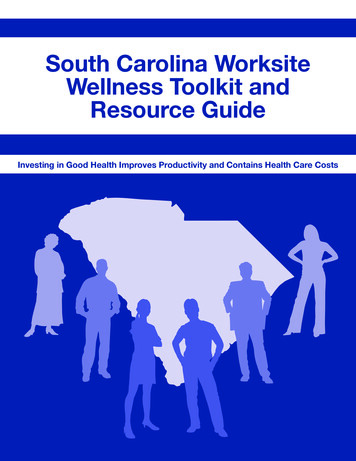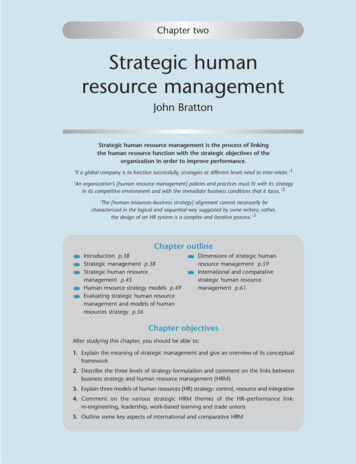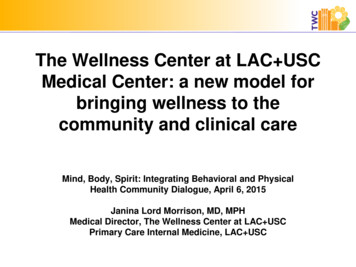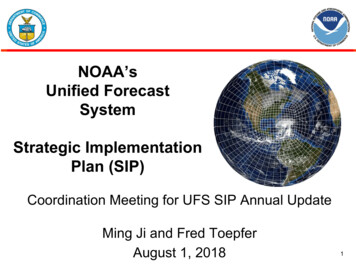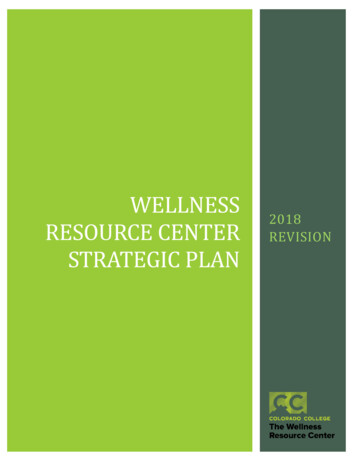
Transcription
Wellness Resource CenterStrategic Plan 2018 RevisionWELLNESSRESOURCE CENTERSTRATEGIC PLAN2018REVISION
Wellness Resource Center Strategic Plan: 2018 RevisionTable of ContentsExecutive Summary . 2Priority 1: Leadership, coordination, and integration of campus health and wellness initiatives. . 3Integrating Academic and Co-Curricular Experiences: . 3Providing Leadership to Prioritize, Integrate, and Coordinate Campus Programs . 4Priority 2: Assess and identify trends and priorities through community engagement, data collection, and analysis . 5Needs Identified from National and CC Data: . 6Mental Health and Suicide: . 6Substance Abuse: . 6Sexual & Relationship Violence:. 7Food and Nutrition: . 9Health Care and Health Care Literacy: . 9Program Evaluation: . 10Future Assessments: . 11Priority 3: Develop and implement high impact, evidence-based strategies to reduce harm, help individuals reach theirfull potential, and foster a healthy inclusive campus community. . 12Mental Health Promotion and Suicide Prevention . 12Develop and Promote a Full Spectrum of Mental Health Support Services . 12Continue and Expand Successful Mental Health Promotion and Suicide Prevention Programs . 13Substance Abuse Prevention . 15Develop Comprehensive Educational Campaign Designed to Work in Tandem with Campus AOD Policies andEnforcement: . 15Sexual and Relationship Violence Prevention . 16Continue and Expand Already Strong Response and Advocacy Efforts. . 16Continue and Expand Already Strong Violence Prevention Efforts. . 16Promote Equity . 17Student Leader Development . 17Improve Communication, Assessment, and Evaluation . 17Nutrition . 17Health and Healthcare Literacy and Sexual Health Programming . 17References . 18Appendix 1: Mental Health & Suicide . 19Appendix 2: Substance Abuse . 19Appendix 3: Sexual Assault . 201
Wellness Resource Center Strategic Plan: 2018 RevisionExecutive SummaryThe Wellness Resource Center approach to wellness isA holistic wellness frameworkholistic and multidimensional, and our mission statementcontributes significantly to studentemphasizes that individual wellness is embedded within anflourishing and thriving by helpinginclusive, healthy community. Our model also emphasizesindividuals reach their full potentialthat wellness is an active process in which individuals learnthrough a collaborative, strengthsbasedapproach that recognizes andand make choices that move them toward achieving their fulladdresses the whole person livingpotential. Indeed, the habits of self-care, critical thinking, andwithin the broader community.community engagement that our students develop at CC willserve them long after graduation as they encounter newchallenges in their worlds of work, relationships, and community.Organizations as diverse as Gallup and the American Association of Colleges and Universities recognizethat wellness is inextricably linked to success in higher education and in life. It may be obvious thatillness and injury can impede learning and discovery, but it is also true that wellness, which includesresilience and confidence enables exploration, discovery, and learning. When flourishing and thriving,students are driven by a sense of purpose and connection to values, which ignite their excitement andengagement with learning opportunities. And, as students engage in a quest for knowledge and anunderstanding of the interconnected nature of our world, they also deepen their own complexunderstanding of themselves as full human beings. In the words of Donald Harward (2016), “Attendingto well-being is to realize a fundamental dimension of the purpose of higher education!”The time is right to update the Wellness Resource Center Strategic Plan. Significant progress has beenmade on the priorities and initiatives identified in the original WRC strategic plan created in 2014.Additionally, other campus initiatives like the JED Campus Project, Equity in Mental Health FrameworkPilot, and the update to the CC Strategic Plan, which share synergies with WRC goals, have generatedmeaningful attention and energy. We can capitalize on this momentum by refining and clarifying ourstrategic initiatives, and by investing in developing capacity across campus to support student andcommunity wellbeing.Key Priorities for the Wellness Resource Center: Provide leadership, coordination, and integration of campus health and wellnessinitiatives. Assess and identify trends and priorities through community engagement, datacollection, and analysis using culturally sensitive and competent strategies. Develop and implement high priority evidence-based strategies to reduce harm andcapitalize on individual protective factors and community protective factors to helpindividuals reach their full potential and foster a healthy inclusive campus community.2
Wellness Resource Center Strategic Plan: 2018 RevisionPriority 1: Leadership, coordination, and integration of campus health andwellness initiatives.The WRC collaborative approach to program development is consistent with the initiatives in the revision of the CCStrategic Plan: Building on the Block: 2.0, such as “Develop new ways to connect efforts that support the curricularand co-curricular. More intentionally connecting academic departments to student life and other offices couldincrease collaboration and eliminate redundancy.” Because we utilize a holistic model and approach, weconsistently strive to connect our work to student learning inside the classroom, and to engage partners acrosscampus to extend our reach, increase the impact of our programs, and reduce redundancy. Addressing overprogramming is a divisional and campus-wide priority. As the campus works to reduce overall programming, wewill need to better prioritize, integrate, and coordinate offerings. Because of our holistic, public-health approach,the WRC is well positioned to play a key role in helping to set priorities for health and wellness-relatedprogramming, as well ensuring that the programming offered on campus is developed with best practices andevidence in mind. We will also work to connect wellness related events and programs across campus, and provideleadership to integrate and coordinate campus health and wellness initiatives within the broad framework of aholistic, multi-dimensional model. Developing strategic college-wide relationships and collaborations will be a keyto success in better integrating and coordinating programming.Integrating Academic and CoCurricular Experiences:The 2014 WRC Strategic Planemphasized articulating and promoting acomprehensive holistic wellness modelbecause students clearly articulated thedesire to live integrated lives. Thisapproach continues to resonate withstudents, as reflected in the updates tothe CC Strategic Plan focused onconnecting the CC experience. Over thelast several years, the WRC has beendeveloping programming designed tocreate space for reflection, build selfawareness, and empower students toexpand their notions of success toinclude failure, resilience, and growth.Because holistic wellness is essentially acollaborative endeavor, we havedeveloped many successfulcollaborations across offices anddepartments. Moving forward, we willbuild upon this foundation to contributeto the institutional goal of helpingstudents integrate their academic and cocurricular experiences with a focus onthe following:Connecting the Curricular and Co-Curricular:Case Study 1In the springs of 2018, the WRC collaborated with Feminist &Gender Studies, The Butler Center, and the Counseling Center tobring researcher Dr. Quenette Walton to campus. She gave a publiclecture titled, “Bridging the Gap: An Intersectional Exploration ofMental Health Disparities Among Middle-class African AmericanWomen.” On the following day, she facilitated a convergence classwith students from two classes (Dr. Chantal Figueroa’s GlobalWomen’s Health, and Dr. Heidi Lewis’ Feminist Theory), and had alunch-time conversation with students from several studentorganizations (Black Women at CC, Mind Body Soul, GROW, andNAMI on Campus). This collaboration is an example of the way theWRC works to directly connect co-curricular prevention and healthpromotion and education with the academic curriculum.Opportunities like this enrich and integrate students’ learning.3
Wellness Resource Center Strategic Plan: 2018 Revision Capitalize on our collaborative model of wellness promotion and education to invigorate the block bydeveloping relationships and programming that connect curricular and co-curricular programming acrossdisciplines.Invest in developing capacity across campus to support student and community wellbeing by building onsuccessful professional development programs and collaborative programming.Build upon the Failure & Resilience Project and continue collaborations with offices like Innovation,Outdoor Education, Arts and Crafts, and the Fine Arts Center to encourage students in building creativity,taking risks, and recovering from failure. These kinds of initiatives also support the mental healthpromotion efforts discussed in more detail below.Build upon successful programming designed to build self-awareness and reflection to help students reflecton, link, and integrate students’ academic and co-curricular experiences.Providing Leadership to Prioritize, Integrate, and Coordinate Campus ProgramsIn our work with students, we often hear that they feel overwhelmed by everything they have on their plates, andthe wealth of campus programming makes it difficult to choose where to invest time. With regard to health andwellness-related programming, we will need to better prioritize, integrate, and coordinate offerings. Grounded inthe trend analyses that we conduct, the WRC can provide leadership in setting priorities informed by anunderstanding of the interconnections between diverse wellness issues (i.e., mental health, suicide, substanceabuse, violence, etc.). We can also utilize our theory-driven and evidence-based Public Health approach to helpensure that the programming offered on campus is developed with best practices and evidence in mind. Areas offocus for this initiative include: Use trend data/information to helpdirect programming toward priorityConnecting the Curricular and Co-Curricular:areasCase Study 2 Develop more collaboration with theIn the fall of 2018, the WRC collaborated with the Crown FacultyCrown Faculty Center in order to betterCenter and Campus Activities and Residential Life to bring sleepintegrate mental health gate-keeperresearcher Dr. Roxanne Prichard to campus. While on campus, sheinformation and professionalconsulted on best practices with the Wellness Resource Center staffdevelopment opportunities into facultyand the Residential Life Coordinators, presented at a Crown Facultyon-boarding and professionallunch about the connections between sleep and academicdevelopment, work on strategies toperformance/success, facilitated a “Sleep 101” workshop forincrease collaboration with faculty instudents, staff, and faculty, and gave a public lecture titled, “Cellorder to connect the curricular and coPhone Use: a Mediating Factor of Undergraduate Health &curricular, and support faculty inWellness.” This set of programs highlighted the connectionsembracing and modeling healthybetween wellbeing and academic success and performance, andbehaviors.engaged faculty in embracing and modeling healthy behaviors. Develop more collaboration withResidential Life. A benefit of being aresidential college is that it allows us tohighlight the pervasive role of wellnessthemes and dimensions in our livesthrough curricular, co-curricular, andcommunity engagement. At this time, we4
Wellness Resource Center Strategic Plan: 2018 Revision are not making the most of this. Examples of high impact collaborations in this area include:o Increased partnerships between the Health Educator and Residential Life Coordinators to betterscreen for substance abuse during conduct processes and to connect students to resources that canhelp them move toward healthy choices so that they can achieve their full potential.o Partnerships between the WRC and Residential Assistants to increase student engagement inopportunities to develop life skills like stress management, conflict management, etc.Provide leadership on the JED Campus Project and the Drug Free Schools and Campuses Act (DFSCA)committee. Prevention and health promotion are the primary focus of the JED strategic plan and of theDFSCA Committee, and this is the focus of the WRC as well.Connect student organizations more meaningfully to offices where they can receive mentorship, training,and content-area advising.Continue to provide leadership on protocol and policy development in areas like immunizations, healthinsurance, and behavioral intervention teams.Connecting and centralizing information and referralso Consistency of messaging in campus prevention programmingo Working collaboratively with other offices (i.e., Counseling, Health Center, Accessibility Resources,Student Success and Advising) to streamline how students can access resources and information Consolidate and expand on-line resources Develop a shared webpage where students, staff, and faculty can access information aboutsupport and reporting resources (examples include Vanderbilt University’s Student CareNetwork, or University of Colorado, Boulder’s Don’t Ignore It webpages and campaign) Links to on-line resources for wellness (i.e., the current WRC list of apps for self-care andself-connection, Cash Course, etc.). Development of a referral repository (i.e., mental health practitioners, LGBTQIA friendlyproviders, general and specialty medical providers, etc.)Priority 2: Assess and identify trends and priorities through communityengagement, data collection, and analysisAccurate data regarding the health and wellness needs of the campus community is the first step in developingnew programs, and supports ongoing program evaluation efforts. In order to identifying trends and priorities, theWRC draws from current research and best practices in the literature, and we engage in ongoing assessmentactivities ranging from regular meetings with CCSGA representatives and other student leaders to formal surveys(WRC-administered and those administered by campus partners). Recent surveys administered by the WRCinclude the Healthy Minds Survey (Spring, 2018; n 778), Think About It (2017 and 2018 First Year StudentCohort), and the National College Health Assessment Survey (Spring, 2017; n 382). During the 2017-2018academic year, the college launched a four-year collaboration with the JED Foundation. As part of thatcollaboration, the campus undertook an extensive self-assessment and review by the JED Campus team, resultingin an action plan and set of recommendations from JED. Additionally, campus partners across campus engaged indata collection through surveys and focus groups during the 2017-2018 academic year, including the StudentTransitions Project and the Food Service Review. Taking all of this information into account, the following needsemerged.5
Wellness Resource Center Strategic Plan: 2018 RevisionNeeds Identified from National and CC Data:Mental Health and Suicide:Multiple national studies (i.e., Twenge, 2017; American College Health Association, 2017; Harris Poll, 2015) havedrawn attention to the fact that today’s college students are less emotionally prepared than previous generations,and they increasingly arrive on campus with histories of significant mental health challenges. Making socialconnections and a sense of belonging are important predictors of student success, resiliency, and thriving.Students of color in particular are more likely to feel emotionally unprepared (Harris, 2015), and face additionalbarriers to access resources and support.Anecdotally, CC students, staff, and faculty identify mental health as a primary issue facing our students. The officeof Accessibility Resources has seen increased demand over the last several years. Of the 18% of CC students whoare fully registered with the office, more than a third receive accommodations for psychological disorders.Demand for appointments at the CC Counseling Center has kept pace with increased staffing over the last severalyears, with more than 30% of CC students utilizing the Counseling Center each year. Because they wereconsistently hearing from their peers about struggles with mental health, the CCSGA made mental health theirfocus during the 2018 spring semester. Members of the CC Honor Council also reported that they were seeingimpacts of mental health challenges in their investigation and hearing processes, prompting them to seekadditional training on identifying and responding to signs of mental distress.Data collected from Colorado College students also indicate that mental health challenges are significantlyimpacting our students. Some key metrics from the Healthy Minds Survey (HSM) and the National College HealthAssessment (NCHA) include: CC students scored low on measures of Flourishing and Resiliency, and expressed asense of isolation; they struggle with high levels of self-injurious behavior and suicidal ideation, and report thatmental health challenges are significantly impacting their academic performance (see Appendix 1 for specificstatistics). Consistent with national data, students from under-represented groups appear to be at increased riskfor mental health challenges on the CC campus.Given the significant impact of mental health challenges and illnesses, and the danger associated withsuicidal ideation and behaviors, mental health promotion and suicide prevention must be priority areas offocus for the campus and the WRC. Attending to the mental health needs of students of color and othermarginalized communities and connecting these efforts to other inclusion and equity initiatives will beparticularly important for success.Substance Abuse:While Jean Twenge’s (2017) iGen research suggests that the current generation of college students may be usingsubstances less, this does not seem to be true of CC students. Data collected from Colorado College studentssuggests that substance abuse is a significant issue on our campus. Some key metrics from the Healthy MindsSurvey (HM), National College Health Assessment (NCHA, 2017), and Think About It survey administered to allincoming students (TAI, 2017) include: CC students use alcohol at higher frequencies and in higher-risk waysbefore matriculation than other college students across the country, and continue to use alcohol and to drink inhigh-risk ways once on campus; they also use other substances at high rates (see Appendix 2 for specific statistics).Harmful and underage drinking and other drug use is a significant public health issue, and the health and safety ofour students is a primary concern for us as a campus. In the United States each year, approximately 1,825 collegestudents die from alcohol-related unintentional injuries; about 696,000 college students are assaulted by another6
Wellness Resource Center Strategic Plan: 2018 Revisionstudent who has been drinking; and about 97,000 students report experiencing alcohol-related sexual assaults(NIH, 2015).Data collected at Colorado College suggests that, congruent with our students’ high rates of substance use, they arealso experiencing significant impacts of this use. In the 2017-2018 academic year, 51.2% of the conduct loadinvolved drug/drug paraphernalia and irresponsible alcohol use and resulted in a range of sanctions includingfines, probation, leaves of absence, suspension, and dismissal. Campus Safety had approximately 216 calls forservice related to alcohol and other drug use during the 2017-2018 academic year. Of those calls, approximately35% resulted in a medical transport due to a wellness/safety assessment. Results from the NCHA (2017) surveyindicate that when they drink, CC students injure themselves, have unprotected sex, and experience nonconsensual sex at significantly higher rates than other college students nationwide. They also experience negativeacademic impacts from their substance use at higher rates than the national average. About 4% of CC studentsseriously consider suicide while drinking (see Appendix 2 for specific statistics).An additional concern for us as a campus is the impact that our culture has on student’s sense of belonging andwell-being. In our conversations with students, the predominant culture on campus is identified as a party culture,and drinking tends to be the focus on social events, rather than a by-product. For example, prior to a campusmusic event, students reported that the primary conversations they were hearing about the event were not aboutthe music, but rather about what substances peers were planning on taking. Anecdotally, we hear from studentswho don’t drink that our campus culture contributes to feelings of not fitting in or difficulty finding a social group.Students have identified that CC is often a difficult place to be when recovering from addiction because substanceuse is so often a focus of social activities. One such student shared an example of how at a celebration for Seniorswhere other students were being served beer and wine, she went to the bar and asked for a non-alcohol beverageand was directed to a water fountain. This made her feel that students who don’t drink are not even recognized bythe institution. This challenge to belonging may be felt more keenly for students of color, who nationally are lesslikely to drink or to drink in high risk ways. Research at other institutions (i.e., Washington, Ziong, Kowalik, 2015)also suggests that students of color are more likely to experience micro-aggressions from their peers who havebeen drinking. We have certainly have heard from students of color who have reported experiencing microaggressions within the context of drunken peers. Creating an inclusive campus community requires criticalassessment of how campus drinking culture impacts how members of marginalized communities feel.Given the significant impact of substance abuse, prevention efforts aimed at reducing substance abuse andchanging the campus culture/climate related to substance use must be priority areas of focus for campusand the WRC. Connecting these efforts to inclusion and equity initiatives across campus, and to mentalhealth promotion and violence prevention efforts will also be a key to success.Sexual & Relationship Violence:Sexual violence and other gender-based violence continues to be a significant public health issue on collegecampuses across the country. National data suggest that approximately 1 in 5 women experience attempted orcompleted sexual assault during their college years. New students to campus are at increased risk for assaultduring the first several months on campus (Kimble, et al., 2007). On the Colorado College campus, there continuesto be high demand for response services from the Sexual Assault Response Coordinator, and data collected fromstudents confirms that rates of sexual assault and other gender-based violence are high. Overall, more than 20% ofCC students experienced unwanted sexual contact within a 12-month period of time, and 9% of CC students7
Wellness Resource Center Strategic Plan: 2018 Revisionexperienced sexual penetration attempt without their consent in the previous 12 months. As noted above, alcoholis a significant factor in sexual assaults on our campus, with 7% of students experienced non-consensual sex whendrinking in the previous 12 months. CC students also reported experiencing emotionally abusive relationship(9%), physically abusive relationships (2%), and stalking (5%) in the previous 12 months. Women on ourcampus are significantly more at risk for all of these experiences except physically abusive relationships, wheremen reported this experience at the same rates as women (see Appendix 3 for specific statistics)Having a comprehensive multi-faceted set ofprevention education programs that targetsall levels of the social ecological model(individual, interpersonal, institutional,community, societal) is a key to effectivelypreventing sexual assault and other genderbased violence (Basile, et. al., 2016).Colorado College completed the CampusPrevention Network (CPN) Sexual AssaultDiagnostic Inventory completed by ColoradoCollege in the Fall of 2017. This instrumentis designed to assess institutional sexualassault prevention efforts, and providesfeedback in three key domains of prevention:Programming, Critical Processes, andInstitutionalization. CC received an overalldesignation of Proficient. We also received aProficient rating for Programming, andCritical Processes, and a Developing designation for Institutionalization. Recommendations of this report can befound in Appendix 4. The decentralization of Title IX response and prevention efforts on the Colorado Collegecampus has created some challenges to developing a coordinated, integrated approach to sexual violenceprevention. The re-integration of the SARC with the WRC has helped to better integrate and coordinate preventionand response activities. Intentional connections with the Anti-Discrimination/Title IX team, which oversees formalTitle IX reports and climate survey data collection is necessary. There are also multiple student groups whoengage in prevention activities who have very different levels of training which do not always include bestpractices like an understanding of how their work fits into the bigger picture of plans and goals for wellness, howto facilitate challenging conversations, or consistency of language, concepts, and institutional messaging. The JEDFoundation has recommended increased oversight of student groups through collaboration with CCSGA, and thismight help to improve the coordination and collaboration of sexual violence prevention programming. Improvingthe communication, coordination, and collaboration between offices would also be helpful.Given the significant impact of sexual and relationship violence, prevention of gender-based and other powerbased violence must be a priority area of focus for campus and the WRC. Improved coordination andcollaboration between campus offices and student groups that focus on sexual assault will be important toimprove sexual and relationship violence prevention efforts, as will continuing to recognize theinterrelationships of
The Wellness Resource Center approach to wellness is holistic and multidimensional, and our mission statement emphasizes that individual wellness is embedded within an inclusive, healthy community. Our model also emphasizes that wellness is an active process in which individuals learn and make choices that move them toward achieving their full


